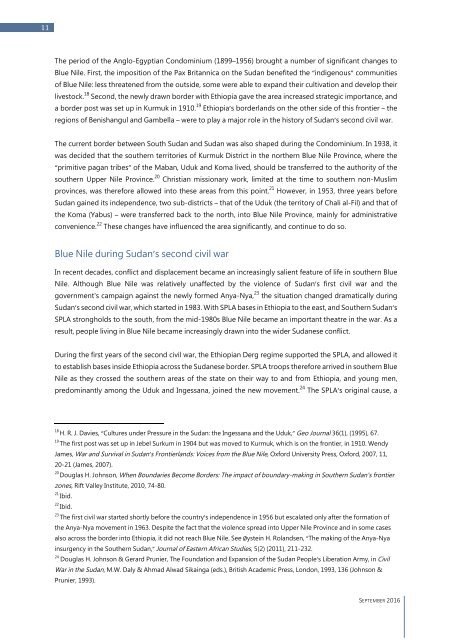A Crisis Normalised
2ctogG9
2ctogG9
Create successful ePaper yourself
Turn your PDF publications into a flip-book with our unique Google optimized e-Paper software.
11 <br />
<br />
The period of the Anglo-Egyptian Condominium (1899–1956) brought a number of significant changes to<br />
Blue Nile. First, the imposition of the Pax Britannica on the Sudan benefited the “indigenous” communities<br />
of Blue Nile: less threatened from the outside, some were able to expand their cultivation and develop their<br />
livestock. 18 Second, the newly drawn border with Ethiopia gave the area increased strategic importance, and<br />
a border post was set up in Kurmuk in 1910. 19 Ethiopia’s borderlands on the other side of this frontier – the<br />
regions of Benishangul and Gambella – were to play a major role in the history of Sudan’s second civil war.<br />
The current border between South Sudan and Sudan was also shaped during the Condominium. In 1938, it<br />
was decided that the southern territories of Kurmuk District in the northern Blue Nile Province, where the<br />
“primitive pagan tribes” of the Maban, Uduk and Koma lived, should be transferred to the authority of the<br />
southern Upper Nile Province. 20 Christian missionary work, limited at the time to southern non-Muslim<br />
provinces, was therefore allowed into these areas from this point. 21 However, in 1953, three years before<br />
Sudan gained its independence, two sub-districts – that of the Uduk (the territory of Chali al-Fil) and that of<br />
the Koma (Yabus) – were transferred back to the north, into Blue Nile Province, mainly for administrative<br />
convenience. 22 These changes have influenced the area significantly, and continue to do so.<br />
Blue Nile during Sudan’s second civil war<br />
In recent decades, conflict and displacement became an increasingly salient feature of life in southern Blue<br />
Nile. Although Blue Nile was relatively unaffected by the violence of Sudan’s first civil war and the<br />
government's campaign against the newly formed Anya-Nya, 23 the situation changed dramatically during<br />
Sudan’s second civil war, which started in 1983. With SPLA bases in Ethiopia to the east, and Southern Sudan’s<br />
SPLA strongholds to the south, from the mid-1980s Blue Nile became an important theatre in the war. As a<br />
result, people living in Blue Nile became increasingly drawn into the wider Sudanese conflict.<br />
During the first years of the second civil war, the Ethiopian Derg regime supported the SPLA, and allowed it<br />
to establish bases inside Ethiopia across the Sudanese border. SPLA troops therefore arrived in southern Blue<br />
Nile as they crossed the southern areas of the state on their way to and from Ethiopia, and young men,<br />
predominantly among the Uduk and Ingessana, joined the new movement. 24 The SPLA’s original cause, a<br />
18<br />
H. R. J. Davies, “Cultures under Pressure in the Sudan: the Ingessana and the Uduk,” Geo Journal 36(1), (1995), 67.<br />
19<br />
The first post was set up in Jebel Surkum in 1904 but was moved to Kurmuk, which is on the frontier, in 1910. Wendy<br />
James, War and Survival in Sudan’s Frontierlands: Voices from the Blue Nile, Oxford University Press, Oxford, 2007, 11,<br />
20-21 (James, 2007).<br />
20<br />
Douglas H. Johnson, When Boundaries Become Borders: The impact of boundary-making in Southern Sudan's frontier<br />
zones, Rift Valley Institute, 2010, 74-80.<br />
21<br />
Ibid.<br />
22<br />
Ibid.<br />
23<br />
The first civil war started shortly before the country’s independence in 1956 but escalated only after the formation of<br />
the Anya-Nya movement in 1963. Despite the fact that the violence spread into Upper Nile Province and in some cases<br />
also across the border into Ethiopia, it did not reach Blue Nile. See Øystein H. Rolandsen, “The making of the Anya-Nya<br />
insurgency in the Southern Sudan,” Journal of Eastern African Studies, 5(2) (2011), 211-232.<br />
24<br />
Douglas H. Johnson & Gerard Prunier, The Foundation and Expansion of the Sudan People’s Liberation Army, in Civil<br />
War in the Sudan, M.W. Daly & Ahmad Alwad Sikainga (eds.), British Academic Press, London, 1993, 136 (Johnson &<br />
Prunier, 1993).<br />
SEPTEMBER 2016


